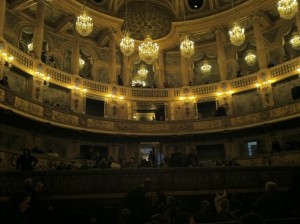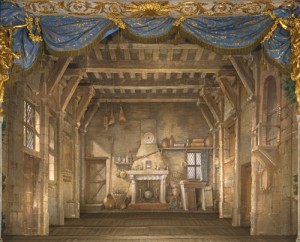Saturday, February 4th at 8 PM
Traditions and customs differ. In France, at the Opera de Versailles the orchestra is not allowed to enter the pit, to warm up on their instruments, until 5 minutes before the curtain rises. In America we all mosey into our places, run a few scales, play a difficult excerpt, look into the audience for old friends and attractive new faces, and talk to each other as we wait for the lights to dim and the concertmaster to “chorale” us into our group tuning. On opening night at Versailles, the door to the pit opens and we enter as a unified body. The audience is already in place and we have only a few moments to focus our energy.

The first thing I notice is that the architecture of the opera house, though beautiful when empty, can not be understood until 850 people are in their seats. I look over the boxes and see couples engaged in conversations, while others are looking here and there. An over stimulated child is being hushed by a smiling proud parent who has brought this 10 year old to the opera for the first time. The beautiful room has become the frame for an excited and enthused living audience. All the musicians recognize the brilliance and success of this 1770 hall where we are about to revive a 1762 opera.
Another thing occurs to me. The opera house is made up of theatrical tricks: Trompe l’oeil, false marble and false bronze. There is so much to beguile the eye and none of it is real. And so, as our audience is ensconced in the unreal, the fantasy of the stage and the story are of a piece with the walls and pillars. At a performance in the Royal Opera at Versailles, everything is theater, nothing is real.
Claire Jolivet, our concertmaster, has tuned the orchestra and we sit for 20 seconds before all the lights dim to black. Then the chandeliers are relit to a low level and they glitter above us. Ryan walks to the podium, takes his bow, turns to the orchestra and gives the most enthusiastic, energetic cue to begin the E flat major fanfare that starts the overture.
While we play the first two acts we can hear clearly the audience’s response. They don’t laugh as much as our audiences in New York or Washington DC. They applaud politely. At intermission, the orchestra players are nervous. We played better than ever and really know this music well. Ryan is conducting so beautifully and the connection between orchestra and the stage is quite good. Do they not like the stage direction? Do they not like the music?
Loretta O’Sullivan and I decide not to leave the pit during the intermission as we simply love being in this space but we don’t talk much.

Intermission is over and we play the third and final act. It too feels good. And then the audience begins to clap. As Ryan leaves the pit, Claire leads us in the final tune to accompany the bowing on stage and we notice that as we play this pretty vaudeville, the applause becomes louder and louder soon gelling into a unified rhythm of clapping. Then feet start stamping. The audience doesn’t want the bowing to stop and more important, they tell us that something wonderful has happened for them over the last 2 hours in this perfect room and with Opera Lafayette. Even from the pit I can see that on stage, bowing, Ryan is moved to tears. And at the end of this first evening, we feel worthy of the palace that has welcomed us.




I can feel the tear of joy shed by Ryan and Opera Lafeyette musicians. Bravo!
From one who was lucky enough to be there, you perfectly capture the mood, the setting, and the experience! You’re so right: after knocking around the theater for a day or two of rehearsals and getting accustomed to the ridiculous splendor of the place, it was a completely different thing to enter the hall and find it full-to-capacity of excited patrons. Only then did it all really make sense.
Bravi tutti. It was magical!